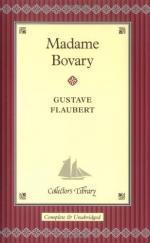The neighbors came to the windows to see their doctor’s new wife.
The old servant presented herself, curtsied to her, apologised for not having dinner ready, and suggested that madame, in the meantime, should look over her house.
Chapter Five
The brick front was just in a line with the street, or rather the road. Behind the door hung a cloak with a small collar, a bridle, and a black leather cap, and on the floor, in a corner, were a pair of leggings, still covered with dry mud. On the right was the one apartment, that was both dining and sitting room. A canary yellow paper, relieved at the top by a garland of pale flowers, was puckered everywhere over the badly stretched canvas; white calico curtains with a red border hung crossways at the length of the window; and on the narrow mantelpiece a clock with a head of Hippocrates shone resplendent between two plate candlesticks under oval shades. On the other side of the passage was Charles’s consulting room, a little room about six paces wide, with a table, three chairs, and an office chair. Volumes of the “Dictionary of Medical Science,” uncut, but the binding rather the worse for the successive sales through which they had gone, occupied almost along the six shelves of a deal bookcase.
The smell of melted butter penetrated through the walls when he saw patients, just as in the kitchen one could hear the people coughing in the consulting room and recounting their histories.
Then, opening on the yard, where the stable was, came a large dilapidated room with a stove, now used as a wood-house, cellar, and pantry, full of old rubbish, of empty casks, agricultural implements past service, and a mass of dusty things whose use it was impossible to guess.
The garden, longer than wide, ran between two mud walls with espaliered apricots, to a hawthorn hedge that separated it from the field. In the middle was a slate sundial on a brick pedestal; four flower beds with eglantines surrounded symmetrically the more useful kitchen garden bed. Right at the bottom, under the spruce bushes, was a cure in plaster reading his breviary.
Emma went upstairs. The first room was not furnished, but in the second, which was their bedroom, was a mahogany bedstead in an alcove with red drapery. A shell box adorned the chest of drawers, and on the secretary near the window a bouquet of orange blossoms tied with white satin ribbons stood in a bottle. It was a bride’s bouquet; it was the other one’s. She looked at it. Charles noticed it; he took it and carried it up to the attic, while Emma seated in an arm-chair (they were putting her things down around her) thought of her bridal flowers packed up in a bandbox, and wondered, dreaming, what would be done with them if she were to die.
During the first days she occupied herself in thinking about changes in the house. She took the shades off the candlesticks, had new wallpaper put up, the staircase repainted, and seats made in the garden round the sundial; she even inquired how she could get a basin with a jet fountain and fishes. Finally her husband, knowing that she liked to drive out, picked up a second-hand dogcart, which, with new lamps and splashboard in striped leather, looked almost like a tilbury.




